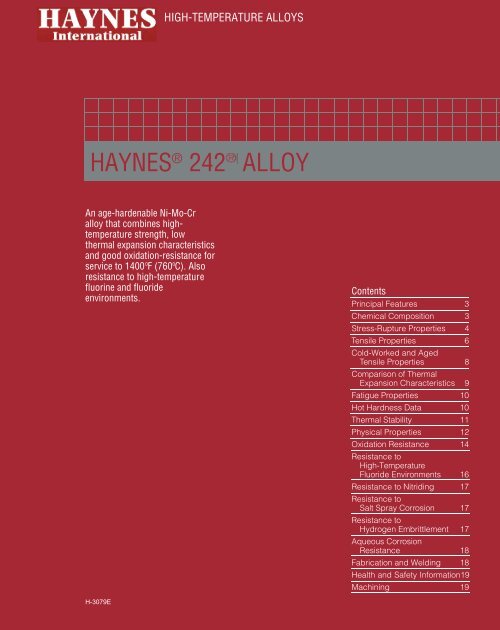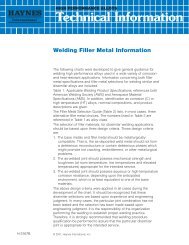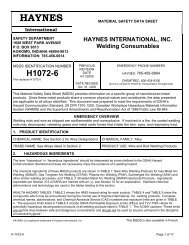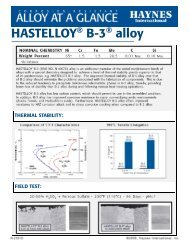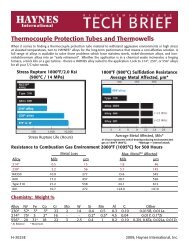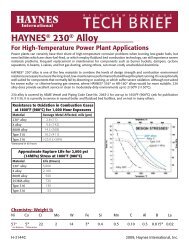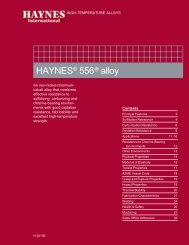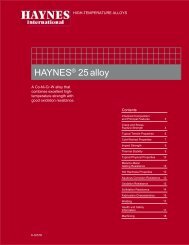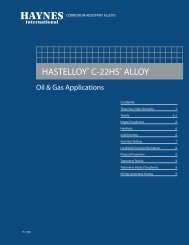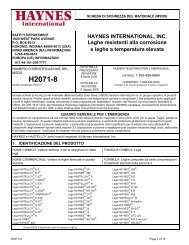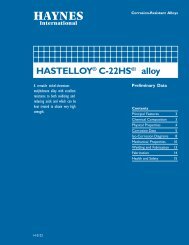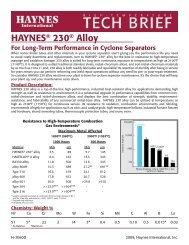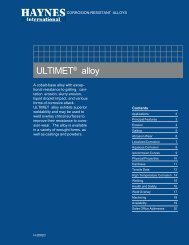HAYNES® 242™ ALLOY - Haynes International, Inc.
HAYNES® 242™ ALLOY - Haynes International, Inc.
HAYNES® 242™ ALLOY - Haynes International, Inc.
You also want an ePaper? Increase the reach of your titles
YUMPU automatically turns print PDFs into web optimized ePapers that Google loves.
HIGH-TEMPERATURE <strong>ALLOY</strong>S<br />
HAYNES ® 242 <strong>ALLOY</strong><br />
An age-hardenable Ni-Mo-Cr<br />
alloy that combines hightemperature<br />
strength, low<br />
thermal expansion characteristics<br />
and good oxidation-resistance for<br />
service to 1400 0 F (760 0 C). Also<br />
resistance to high-temperature<br />
fluorine and fluoride<br />
environments.<br />
Contents<br />
Principal Features 3<br />
Chemical Composition 3<br />
Stress-Rupture Properties 4<br />
Tensile Properties 6<br />
Cold-Worked and Aged<br />
Tensile Properties 8<br />
Comparison of Thermal<br />
Expansion Characteristics 9<br />
Fatigue Properties 10<br />
Hot Hardness Data 10<br />
Thermal Stability 11<br />
Physical Properties 12<br />
Oxidation Resistance 14<br />
Resistance to<br />
High-Temperature<br />
Fluoride Environments 16<br />
Resistance to Nitriding 17<br />
Resistance to<br />
Salt Spray Corrosion 17<br />
Resistance to<br />
Hydrogen Embrittlement 17<br />
Aqueous Corrosion<br />
Resistance 18<br />
Fabrication and Welding 18<br />
Health and Safety Information19<br />
Machining 19<br />
H-3079E
NEW LONG-RANGE-ORDER STRENGTHENING MECHANISM<br />
HAYNES ® 242 alloy derives its<br />
age-hardened strength from a<br />
unique long-range-ordering<br />
reaction which essentially<br />
doubles the un-aged strength<br />
while preserving excellent<br />
ductility. The ordered<br />
Ni 2<br />
(Mo,Cr)-type domains<br />
are less than a few hundred<br />
Angstroms in size, and are<br />
visible only with the use of<br />
electron microscopy.<br />
Transmission electron micrograph showing long-range-ordered domains (dark lenticular particles) in<br />
242 TM alloy. (Courtesy Dr. Vijay Vasudevan, University of Cincinnati). Sample was solution heat<br />
treated at 2012 0 F (1100 0 C) and aged for 100 hours at 1200 0 F (650 0 C).<br />
© 2000 by <strong>Haynes</strong> <strong>International</strong>, <strong>Inc</strong>.<br />
HAYNES 242 alloy<br />
2
PRINCIPAL FEATURES<br />
Excellent High-Temperature<br />
Strength, Low Thermal Expansion<br />
Characteristics, and<br />
Good Oxidation Resistance<br />
HAYNES ® 242 alloy is an agehardenable<br />
nickel-molybdenumchromium<br />
alloy which derives its<br />
strength from a long-rangeordering<br />
reaction upon aging. It<br />
has tensile and creep strength<br />
properties up to 1300 0 F (705 0 C)<br />
which are as much as double<br />
those for solid solution strengthened<br />
alloys, but with high<br />
ductility in the aged condition.<br />
The thermal expansion characteristics<br />
of 242 alloy are much<br />
lower than those for most other<br />
alloys, and it has very good<br />
oxidation resistance up to 1500 0 F<br />
(815 0 C). Other attractive features<br />
include excellent low cycle<br />
fatigue properties, very good<br />
thermal stability, and resistance<br />
to high-temperature fluorine and<br />
fluoride environments.<br />
Fabrication<br />
HAYNES 242 alloy has very<br />
good forming and welding<br />
characteristics in the annealed<br />
condition. It may be forged or<br />
otherwise hot-worked by<br />
conventional techniques, and it<br />
is readily cold formable.<br />
Welding may be performed in<br />
the annealed condition by<br />
standard gas tungsten arc<br />
(GTAW) or gas metal arc<br />
(GMAW) techniques. Use of<br />
matching composition filler<br />
metal is suggested. For further<br />
information on forming and<br />
fabrication, contact <strong>Haynes</strong><br />
<strong>International</strong>.<br />
Heat Treatment<br />
HAYNES 242 alloy is furnished<br />
in the annealed condition,<br />
unless otherwise specified. The<br />
alloy is usually annealed in the<br />
range of 1900-2050 0 F (925-<br />
1120 0 C), depending upon<br />
specific requirements, followed<br />
by an air cool (or more rapid<br />
cooling) before aging. A water<br />
quench is recommended for<br />
heavy section components.<br />
Aging is performed at 1200 0 F<br />
(650 0 C) for a period of 24-48<br />
hours, followed by an air cool.<br />
Available in Convenient Forms<br />
HAYNES 242 alloy is produced<br />
in the form of reforge billet, bar,<br />
plate, sheet, and wire welding<br />
products, all in various sizes.<br />
Other forms may be produced<br />
upon request.<br />
Applications<br />
HAYNES 242 alloy combines<br />
properties which make it<br />
ideally suited for a variety of<br />
component applications in<br />
the aerospace industry. It will<br />
be used for seal rings,<br />
containment rings, duct<br />
segments, casings, fasteners,<br />
rocket nozzles, pumps, and<br />
many others. In the chemical<br />
process industry, 242 alloy<br />
will find use in high-temperature<br />
hydrofluoric acid vaporcontaining<br />
processes as a<br />
consequence of its excellent<br />
resistance to that environment.<br />
The alloy also displays<br />
excellent resistance to hightemperature<br />
fluoride salt<br />
mixtures. The high strength<br />
and fluorine environmentresistance<br />
of 242 alloy has<br />
also been shown to provide<br />
for excellent service in<br />
fluoroelastomer process<br />
equipment, such as extrusion<br />
screws.<br />
CHEMICAL COMPOSITION, PERCENT<br />
Ni Mo Cr Fe Co Mn Si Al C B Cu<br />
65 a 24.0- 7.0- 2.0* 2.5* 0.80* 0.80* 0.50* 0.03* 0.006* 0.50*<br />
26.0 9.0-<br />
a<br />
As balance<br />
*Maximum<br />
3<br />
HAYNES 242 alloy
STRESS-RUPTURE STRENGTH<br />
HAYNES ® 242 alloy is an agehardenable<br />
material which<br />
combines excellent strength<br />
and ductility in the aged<br />
condition with good<br />
fabricability in the annealed<br />
condition. It is particularly<br />
effective for strength-limited<br />
applications up to 1300 0 F<br />
(705 0 C), where its strength is as<br />
much as double that for typical<br />
solid-solution strengthened<br />
alloys. It may be used at higher<br />
temperatures, where its<br />
solid-solution strength is<br />
still excellent, but oxidation<br />
resistance limits such<br />
uses to about 1500-<br />
1600 0 F (815-870 0 C).<br />
COMPARISON OF 100 HOUR STRESS-RUPTURE STRENGTHS*<br />
<strong>Haynes</strong> 242 alloy<br />
4
STRESS-RUPTURE STRENGTH (continued)<br />
HOT-ROLLED PLATE – ANNEALED AND AGED<br />
Test<br />
Approximate Initial Stress, Ksi (MPa)<br />
Temperature<br />
Required to Cause Rupture in Specified Time<br />
0<br />
F ( 0 C) 10 Hrs. 100 Hrs. 1000 Hrs.<br />
1000 (540) 160 (1105) 140 (965) 120 (825)<br />
1100 (595) 130 (895) 110 (760) 93 (640)<br />
1200 (650) 105 (725) 90 (620) 75 (515)<br />
1300 (705) 86 (595) 69 (475) 35 (240)<br />
1400 (760) 62 (425) 29 (200) 17 (115)<br />
1500 (815) 26 (180) 16 (110) 11 (76)<br />
1600 (870) 15 (105) 11 (74) –<br />
5<br />
HAYNES 242 alloy
TENSILE PROPERTIES<br />
BAR AND RINGS – ANNEALED AND AGED<br />
Ultimate<br />
Test Tensile 0.2% Yield Elongation Reduction<br />
Temperature Strength Strength in 4D in Area<br />
0<br />
F ( 0 C) Ksi MPa Ksi MPa % %<br />
Room 187.4 1290 122.4 845 33.7 45.7<br />
200 (95) 180.7 1245 110.4 760 31.7 47.0<br />
400 (205) 173.5 1195 102.3 705 33.0 51.8<br />
600 (315) 168.6 1160 96.5 665 33.4 48.4<br />
800 (425) 161.3 1110 86.3 595 37.6 45.9<br />
1000 (540) 156.3 1080 78.3 540 38.3 49.9<br />
1200 (650) 144.9 1000 82.7 570 33.2 41.1<br />
1400 (760) 106.2 730 44.9 310 44.3 54.1<br />
1600 (870) 72.5 500 44.8 310 49.7 85.1<br />
1800 (980) 42.0 290 30.6 210 54.0 97.8<br />
COMPARISON OF YIELD STRENGTHS AND ELONGATIONS*<br />
HAYNES ® 242 alloy exhibits<br />
much higher yield strength than<br />
typical solid-solution-strengthened<br />
nickel-base alloys, such<br />
as HASTELLOY ® S alloy, but<br />
also possesses excellent<br />
ductility in the fully heat-treated<br />
condition. This can translate into<br />
excellent containment characteristics<br />
for gas turbine rings<br />
and casings, particularly when<br />
coupled with 242 alloy's lower<br />
expansion coefficient and<br />
excellent ductility retention<br />
following thermal exposure. This<br />
combination is also well suited<br />
for a range of fastener and<br />
bolting applications up to<br />
1300 0 F (705 0 C).<br />
HAYNES 242 alloy<br />
6
TENSILE PROPERTIES (continued)<br />
HOT-ROLLED PLATE – ANNEALED AND AGED (a)<br />
Ultimate<br />
Test Tensile 0.2% Yield Elongation Reduction<br />
Temperature Strength Strength in 4D in Area<br />
0<br />
F ( 0 C) Ksi MPa Ksi MPa % %<br />
75 (25) 193 1330 126 868 36 –<br />
400 (205) 176 1213 101 696 43 52<br />
800 (425) 165 1137 91 627 45 52<br />
1000 (540) 164 1130 89 613 44 51<br />
1100 (595) 160 1102 89 613 44 51<br />
1200 (650) 141 971 87 599 29 31<br />
1300 (705) 118 813 73 503 28 30<br />
COLD-ROLLED SHEET – ANNEALED AND AGED (a)<br />
Ultimate<br />
Test Tensile 0.2% Yield Elongation Reduction<br />
Temperature Strength Strength in 4D in Area<br />
0<br />
F ( 0 C) Ksi MPa Ksi MPa % %<br />
75 (25) 187 1288 120 827 38 –<br />
1000 (540) 165 1137 106 730 31 –<br />
1100 (595) 150 1034 102 703 18 –<br />
1200 (650) 135 930 96 661 14 –<br />
1300 (705) 109 751 83 572 10 –<br />
(a) Average of two tests per heat, two heats of each product form.<br />
Solution Annealed + Aged 1200 0 F-48 hr.<br />
7 HAYNES 242 alloy
TENSILE PROPERTIES (continued)<br />
COLD-REDUCED SHEET – AS COLD-WORKED AND COLD-WORKED PLUS AGED<br />
HAYNES ® 242 alloy has excellent<br />
strength and ductility as a<br />
cold-reduced and directly aged<br />
product. Coupled with its low<br />
thermal expansion characteristics,<br />
this makes it an excellent<br />
choice for fasteners and springs.<br />
Ultimate<br />
Test Tensile 0.2% Yield Elongation<br />
Temperature Strength Strength in 2 in. (50 mm)<br />
0<br />
F ( 0 C) Ksi MPa Ksi MPa %<br />
M.A. Room 137.6 950 65.3 450 47<br />
M.A. + 20% C.W. Room 169.6 1170 139.5 960 20<br />
M.A. + 40% C.W. Room 217.9 1500 181.3 1250 8<br />
M.A. + Age Room 192.0 1325 130.0 895 32<br />
M.A. + 20% C.W. + Age Room 209.5 1445 173.0 1195 21<br />
M.A. + 40% C.W. + Age Room 244.7 1685 219.7 1515 11<br />
M.A. + 40% C.W. + Age 1100 (595) 201.9 1390 191.4 1320 11<br />
M.A. + 40% C.W. + Age 1200 (650) 198.7 1370 145.9 1005 8<br />
M.A. + 40% C.W. + Age 1300 (705) 183.7 1265 134.3 925 11<br />
M.A. + 40% C.W. + Age 1400 (760) 156.0 1075 94.1 650 32<br />
*M.A. = Solution Anneal; C.W. = Cold Work; Age = Standard Aging Treatment.<br />
COMPARATIVE FASTENER <strong>ALLOY</strong> TENSILE PROPERTIES*<br />
HAYNES 242 alloy compares<br />
very favorably with other coldworked<br />
and directly aged<br />
fastener alloys. The graphs<br />
below present comparative<br />
room temperature tensile<br />
properties for 40% coldreduced<br />
and aged sheet<br />
product.<br />
Ultimate and Yield Strength<br />
Elongation<br />
STRESS, Ksi<br />
250<br />
200<br />
150<br />
100<br />
50<br />
242 TM<br />
alloy<br />
Alloy<br />
718<br />
UTS-<br />
YS-<br />
Alloy<br />
A-286<br />
1500<br />
1000<br />
500<br />
STRESS, MPa<br />
ELONGATION, % in 2 in. (50 mm)<br />
10<br />
8<br />
6<br />
4<br />
2<br />
242 TM<br />
alloy<br />
Alloy<br />
718<br />
Alloy<br />
A-286<br />
*Alloys cold-rolled to 40% reduction. 242 alloy aged 1200 0 F (650 0 C)/24 hours/AC; alloy 718 aged 1325 0 F (720 0 C)/8 hours/FC to 1150 0 F (620 0 C)/8<br />
hours/AC; alloy A-286 aged 1200 0 F (650 0 C)16 hours/AC.<br />
HAYNES 242 alloy<br />
8
COMPARISON OF THERMAL EXPANSION CHARACTERISTICS<br />
HAYNES ® 242 alloy exhibits<br />
significantly lower thermal<br />
expansion characteristics than<br />
most nickel-base high-temperature<br />
alloys in the range of<br />
temperature from room temperature<br />
to 1600 0 F (870 0 C). Although<br />
its expansion is greater than<br />
that for alloy 909 below 1000 0 F<br />
(540 0 C), at higher temperatures,<br />
the difference narrows<br />
considerably.<br />
TOTAL THERMAL EXPANSION, ROOM TO ELEVATED TEMPERATURE<br />
MEAN COEFFICIENT OF THERMAL EXPANSION<br />
The following compares the mean coefficient of expansion for several alloys:<br />
Mean Coefficient of Expansion<br />
From RT to Temperature, in./in.- 0 F (mm/mm- 0 C) x 10 -6<br />
Material 1000 0 F (540 0 C) 1100 0 F (595 0 C) 1200 0 F (650 0 C) 1300 0 F (705 0 C) 1400 0 F (760 0 C)<br />
Alloy 909 5.0 (9.0) 5.4 (9.7) 5.8 (10.4) 6.2 (11.2) 6.6 (11.9)<br />
242 TM alloy 6.8 (12.2) 6.8 (12.3) 7.0 (12.6) 7.2 (13.0) 7.7 (13.9)<br />
Alloy B 6.7 (12.0) 6.7 (12.0) 6.7 (12.0) 6.9 (12.4) 7.1 (12.8)<br />
Alloy N 7.3 (13.1) 7.4 (13.3) 7.5 (13.5) 7.6 (13.7) 7.8 (14.0)<br />
Alloy S 7.4 (13.2) 7.5 (13.5) 7.6 (13.7) 7.8 (14.0) 8.0 (14.4)<br />
Alloy X 8.4 (15.1) 8.5 (15.3) 8.6 (15.5) 8.6 (15.7) 8.8 (15.8)<br />
9<br />
HAYNES 242 alloy
LOW CYCLE FATIGUE PROPERTIES<br />
STRAIN-CONTROLLED LCF PROPERTIES (HOT-ROLLED PLATE)<br />
The following LCF properties<br />
were generated from hot-rolled<br />
and fully heat-treated plate.<br />
Testing was performed in the<br />
transverse direction utilizing a<br />
smooth, round bar specimen<br />
geometry. The specimens were<br />
tested by fully reversed axial<br />
strain cycling, R-ratio of -1.0,<br />
and a cycle frequency of 20<br />
cpm (0.33 Hz) at a strain range<br />
of 1%.<br />
Cycles to Failure at 1200 0 F (650 0 C), N F<br />
HAYNES ® 242 TM alloy HASTELLOY ® X alloy HAYNES 188 alloy HAYNES HR-120 ® alloy<br />
2000 4000 2100 3600<br />
STRESS-CONTROLLED NOTCHED LCF PROPERTIES (HOT-ROLLED RINGS)<br />
The following test results were<br />
generated from hot-rolled and<br />
fully heat-treated rings destined<br />
for actual gas turbine engine<br />
part applications. Testing was<br />
performed in the tangential<br />
direction utilizing a round test<br />
bar geometry with a double<br />
notch design (K t<br />
=2.18). Loading<br />
was uniaxial cycling with an<br />
R-ratio of 0.05 stress and a<br />
cycle frequency of 20 cpm<br />
(0.33 Hz).<br />
Maximum Stress<br />
Cycles to Failure at 1200 0 F (650 0 C), N F<br />
Ksi MPa 242 TM alloy Alloy 909<br />
110 760 845 2,835<br />
100 690 12,220 22,568<br />
95 655 32,587 13,796<br />
90 620 76,763 59,679; 40,525<br />
85 585 297,848 47,707; 43,701<br />
80 550 304,116* 129,573**<br />
* No crack observed at 198,030 cycles. 8 mil (200µm) crack observed at 200,000 cycles.<br />
**No crack observed at 45,800 cycles. 8 mil (200µm) crack observed at 47,770 cycles.<br />
HIGH-TEMPERATURE HARDNESS PROPERTIES<br />
The following are results from standard vacuum furnace hot hardness tests. Values are given in originally<br />
measured DPH (Vickers) units and conversions to Rockwell C/B scale in parentheses.<br />
Vickers Diamond Pyramid Hardness (Rockwell C/B Hardness)<br />
Material 800 0 F (425 0 C) 1000 0 F (540 0 C) 1200 0 F (650 0 C) 1400 0 F (760 0 C) 1600 0 F (870 0 C)<br />
242 TM alloy 271 (R C<br />
26) 263 (R C<br />
24) 218 (R B<br />
95) 140 (R B<br />
75) 78<br />
Alloy 6B 269 (R C<br />
26) 247 (R C<br />
22) 225 (R B<br />
98) 153 (R B<br />
81) 91<br />
Alloy 25 171 (R B<br />
87) 160 (R B<br />
83) 150 (R B<br />
80) 134 (R B<br />
74) 93<br />
Alloy 188 170 (R B<br />
86) 159 (R B<br />
83) 147 (R B<br />
77) 129 (R B<br />
72) 89<br />
230 ® alloy 142 (R B<br />
77) 139 (R B<br />
76) 132 (R B<br />
73) 125 (R B<br />
70) 75<br />
556 TM alloy 132 (R B<br />
73) 129 (R B<br />
72) 118 (R B<br />
67) 100 (R B<br />
55) 67<br />
HAYNES 242 alloy<br />
10
THERMAL STABILITY<br />
HAYNES ® 242 alloy has excellent<br />
retained ductility and impact<br />
strength after long-term thermal<br />
exposure at temperature.<br />
Combined with its high strength<br />
and low thermal expansion<br />
characteristics, this makes for<br />
very good containment properties<br />
in gas turbine static structures.<br />
The graphs below<br />
show the retained roomtemperature<br />
tensile elongation<br />
and impact strength for<br />
242 alloy versus other<br />
relevent materials after a<br />
4000 hour exposure at<br />
1200 0 F (650 0 C).<br />
COMPARATIVE RETAINED DUCTILITY AND IMPACT STRENGTH<br />
Room-Temperature Tensile Elongation<br />
Room Temperature Impact Strength<br />
%<br />
60<br />
50<br />
40<br />
30<br />
20<br />
10<br />
Alloy<br />
S<br />
Alloy<br />
B<br />
242<br />
alloy<br />
Alloy<br />
909<br />
Alloy<br />
S<br />
Alloy<br />
B<br />
242<br />
alloy<br />
Alloy<br />
909<br />
60<br />
50<br />
40<br />
30<br />
20<br />
10<br />
Foot – Pounds<br />
150<br />
125<br />
100<br />
75<br />
50<br />
25<br />
Alloy<br />
S<br />
Alloy242<br />
B alloy<br />
Alloy<br />
909<br />
Alloy<br />
S<br />
Alloy<br />
B<br />
242<br />
alloy<br />
Alloy<br />
909<br />
200<br />
150<br />
100<br />
50<br />
Joules<br />
Unexposed<br />
1200 0 F (650 0 C) for<br />
4000 Hours*<br />
Unexposed<br />
1200 0 F (650 0 C) for<br />
4000 Hours*<br />
*Alloy 909 data for 1000 hours.<br />
ROOM-TEMPERATURE PROPERTIES AFTER EXPOSURE AT 1200 0 F (650 0 C)*<br />
Ultimate<br />
Exposure Tensile 0.2% Yield Elongation Reduction Charpy<br />
Time Strength Strength in 2 in. (50 mm) in Area V-Notch<br />
Hours Ksi MPa Ksi MPa % % Ft.-lbs. Joules<br />
0 179 1235 110 760 39 44 66 90<br />
1000 194 1340 119 820 28 38 41 56<br />
4000 196 1350 122 840 25 37 31 42<br />
8000 193 1330 121 835 24 39 26 35<br />
*Samples machined from plate after exposure. Duplicate tests.<br />
11<br />
HAYNES 242 alloy
TYPICAL PHYSICAL PROPERTIES<br />
Temp., 0 F British Units Temp., 0 C Metric Units<br />
Density Room 0.327 lb/in 3 Room 9.05 g/cm 3<br />
Melting Range 2350-2510 1290-1375<br />
Electrical Room 48.0 µohm-in Room 122.0 µohm-cm<br />
Resistivity 200 48.5 µohm-in 100 123.4 µohm-cm<br />
400 49.3 µohm-in 200 125.1 µohm-cm<br />
600 50.0 µohm-in 300 126.7 µohm-cm<br />
800 50.6 µohm-in 400 128.0 µohm-cm<br />
1000 51.1 µohm-in 500 129.5 µohm-cm<br />
1200 51.7 µohm-in 600 130.6 µohm-cm<br />
1400 52.4 µohm-in 700 132.0 µohm-cm<br />
1600 51.3 µohm-in 800 132.4 µohm-cm<br />
1800 50.4 µohm-in 900 129.8 µohm-cm<br />
1000 127.6 µohm-cm<br />
Thermal Diffusivity Room 4.7 x 10 -3 in 2 /sec Room 30.5 x 10 -3 cm 2 /sec<br />
200 5.1 x 10 -3 in 2 /sec 100 32.9 x 10 -3 cm 2 /sec<br />
400 5.6 x 10 -3 in 2 /sec 200 35.9 x 10 -3 cm 2 /sec<br />
600 6.1 x 10 -3 in 2 /sec 300 39.0 x 10 -3 cm 2 /sec<br />
800 6.6 x 10 -3 in 2 /sec 400 41.9 x 10 -3 cm 2 /sec<br />
1000 7.2 x 10 -3 in 2 /sec 500 45.0 x 10 -3 cm 2 /sec<br />
1200 7.9 x 10 -3 in 2 /sec 600 48.1 x 10 -3 cm 2 /sec<br />
1400 7.2 x 10 -3 in 2 /sec 700 51.2 x 10 -3 cm 2 /sec<br />
1600 7.0 x 10 -3 in 2 /sec 800 44.2 x 10 -3 cm 2 /sec<br />
1800 7.6 x 10 -3 in 2 /sec 900 46.6 x 10 -3 cm 2 /sec<br />
1000 49.6 x 10 -3 cm 2 /sec<br />
Thermal Room 75.7 BTU-in/ft 2 hr.- 0 F Room 11.3 W/m-K<br />
Conductivity 200 83.6 BTU-in/ft 2 hr- 0 F 100 12.6 W/m-K<br />
400 96.1 BTU-in/ft 2 hr- 0 F 200 14.2 W/m-K<br />
600 108.5 BTU-in/ft 2 hr- 0 F 300 15.9 W/m-K<br />
800 120.9 BTU-in/ft 2 hr- 0 F 400 17.5 W/m-K<br />
1000 133.3 BTU-in/ft 2 hr- 0 F 500 19.2 W/m-K<br />
1200 145.7 BTU-in/ft 2 hr- 0 F 600 20.9 W/m-K<br />
1400 158.2 BTU-in/ft 2 hr- 0 F 700 22.5 W/m-K<br />
1600 170.6 BTU-in/ft 2 hr- 0 F 800 24.2 W/m-K<br />
1800 183.0 BTU-in/ft 2 hr- 0 F 900 25.8 W/m-K<br />
1000 27.5 W/m-K<br />
HAYNES 242 alloy<br />
12
TYPICAL PHYSICAL PROPERTIES (continued)<br />
Temp., 0 F British Units Temp., 0 C Metric Units<br />
Specific Heat Room 0.092 BTU/lb- 0 F Room 386 J/Kg-k<br />
200 0.097 BTU/lb- 0 F 100 405 J/Kg-K<br />
400 0.100 BTU/lb- 0 F 200 419 J/Kg-K<br />
600 0.103 BTU/lb- 0 F 300 431 J/Kg-K<br />
800 0.106 BTU/lb- 0 F 400 439 J/Kg-K<br />
1000 0.110 BTU/lb- 0 F 500 451 J/Kg-K<br />
1200 0.118 BTU/lb- 0 F 600 470 J/Kg-K<br />
1400 0.144 BTU/lb- 0 F 700 595 J/Kg-K<br />
1600 0.146 BTU/lb- 0 F 800 605 J/Kg-K<br />
1800 0.150 BTU/lb- 0 F 900 610 J/Kg-K<br />
1000 627 J/Kg-K<br />
Mean Coefficient of 70-200 6.0 microinches/in- 0 F 25-100 10.8 µm/m- 0 C<br />
Thermal Expansion 70-400 6.3 microinches/in- 0 F 25-200 11.3 µm/m- 0 C<br />
70-600 6.5 microinches/in- 0 F 25-300 11.6 µm/m- 0 C<br />
70-800 6.7 microinches/in- 0 F 25-400 11.9 µm/m- 0 C<br />
70-1000 6.8 microinches/in- 0 F 25-500 12.2 µm/m- 0 C<br />
70-1100 6.8 microinches/in- 0 F 25-600 12.3 µm/m- 0 C<br />
70-1200 6.9 microinches/in- 0 F 25-650 12.4 µm/m- 0 C<br />
70-1300 7.2 microinches/in- 0 F 25-700 13.0 µm/m- 0 C<br />
70-1400 7.7 microinches/in- 0 F 25-750 13.7 µm/m- 0 C<br />
70-1600 8.0 microinches/in- 0 F 25-800 14.0 µm/m- 0 C<br />
70-1800 8.3 microinches/in- 0 F 25-900 14.5 µm/m- 0 C<br />
25-1000 15.0 µm/m- 0 C<br />
DYNAMIC MODULUS OF ELASTICITY<br />
Dynamic<br />
Dynamic<br />
Modulus of<br />
Modulus of<br />
Elasticity,<br />
Elasticity,<br />
Temp., 0 F 10 6 psi Temp., 0 C GPa<br />
Room 33.2 Room 229<br />
200 32.7 100 225<br />
400 31.8 200 219<br />
600 30.8 300 213<br />
800 29.7 400 206<br />
1000 28.6 500 199<br />
1200 27.6 600 193<br />
1400 25.7 700 185<br />
1600 24.0 800 172<br />
1800 22.4 900 163<br />
1000 152<br />
13<br />
HAYNES 242 alloy
OXIDATION RESISTANCE<br />
HAYNES ® 242 alloy exhibits<br />
very good oxidation resistance<br />
at temperatures up to 1500 0 F<br />
(815 0 C), and should not require<br />
protective coatings for continuous<br />
or intermittent service at<br />
these temperatures. The alloy is<br />
not specifically designed for<br />
use at higher temperatures, but<br />
can tolerate short-term exposures.<br />
SCHEMATIC REPRESENTATION OF METALLOGRAPHIC TECHNIQUE<br />
USED FOR EVALUATING OXIDATION TESTS<br />
1. Metal Loss = (A – B)/2<br />
2. Average Internal Penetration = C<br />
3. Maximum Internal Penetration = D<br />
4. Average Metal Affected = ((A – B)/2) + C<br />
5. Maximum Metal Affected = ((A – B)/2) + D<br />
COMPARATIVE BURNER RIG OXIDATION-RESISTANCE AT 1400 0 F (760 0 C) FOR 500 HOURS<br />
Average<br />
Maximum<br />
Metal Metal Metal<br />
Loss Affected Affected<br />
Alloy Mils µm Mils µm Mils µm<br />
HASTELLOY ® N alloy 0.7 18 0.8 20 1.2 30<br />
242 TM alloy 1.1 28 1.2 30 1.6 41<br />
HASTELLOY B alloy 1.8 46 2.6 66 2.8 71<br />
Alloy 909 0.3 8 10.8 275 12.8 325<br />
Oxidation Test Parameters<br />
Burner rig oxidation tests were<br />
conducted by exposing samples<br />
3/8 inch x 2.5 inches x thickness<br />
(9mm x 64mm x thickness), in a<br />
rotating holder, to the products of<br />
combustion of No. 2 fuel oil<br />
burned at a ratio of air to fuel of<br />
about 50:1. (Gas velocity was<br />
about 0.3 mach). Samples were<br />
automatically removed from the<br />
gas stream every 30 minutes and<br />
fan-cooled to near ambient<br />
temperature and then reinserted<br />
into the flame tunnel.<br />
HAYNES 242 alloy 14
BURNER RIG OXIDATION-RESISTANCE (continued)<br />
HAYNES ® 242 alloy<br />
Average Metal Affected = 1.2 Mils (30 µm)<br />
HASTELLOY ® B alloy<br />
Average Metal Affected = 2.6 Mils (66 µm)<br />
Microstructures shown relate to<br />
the burner rig oxidation test<br />
data shown on the page<br />
opposite for three of the<br />
materials evaluated. The black<br />
area shown at the top of the<br />
pictures for 242 TM alloy and<br />
alloy B represent thickness loss<br />
during the test. The alloy 909<br />
apparently exhibited only minor<br />
thickness loss. This is believed<br />
to be a consequence of the<br />
sample actually swelling during<br />
the exposure due to oxygen<br />
absorption. The sample also<br />
developed a very thick, coarse<br />
scale and extensive internal<br />
oxidation. There was also<br />
evidence of significant cracking<br />
in the alloy 909 specimen<br />
due to the thermal cycling,<br />
even though the test samples<br />
were not constrained.<br />
Alloy 909<br />
Average Metal Affected = 10.8 Mils (275 µm)<br />
COMPARATIVE OXIDATION-RESISTANCE IN FLOWING AIR<br />
AT 1500 0 F (815 0 C) FOR 1008 HOURS*<br />
Metal Loss<br />
Average Metal Affected<br />
Alloy Mils µm Mils µm<br />
242 TM alloy 0.0 0 0.5 13<br />
HASTELLOY ® S alloy 0.0 0 0.5 13<br />
HASTELLOY X alloy 0.1 3 1.1 28<br />
HASTELLOY N alloy 0.4 10 1.2 30<br />
HASTELLOY B alloy 7.2 183 8.2 208<br />
Alloy 909 4.4 112 19.4 493<br />
*Coupons exposed to flowing air at a velocity of 7.0 feet/minute (2.1m/minute) past the samples. Samples cycled to room temperature once-a-day.<br />
15<br />
HAYNES 242 alloy
RESISTANCE TO HIGH-TEMPERATURE FLUORIDE ENVIRONMENTS<br />
Research has shown that<br />
materials which have high<br />
molybdenum content and low<br />
chromium content are generally<br />
superior to other materials in<br />
resisting high-temperature<br />
corrosion in fluorine-containing<br />
environments. HAYNES ®<br />
242 alloy is in that category,<br />
and displays excellent resistance<br />
to both fluoride gas and<br />
fluoride salt environments.<br />
COMPARATIVE RESISTANCE TO 70% HF AT 1670 0 F (910 0 C) FOR 136 HOURS<br />
Thickness Loss<br />
Alloy Mils mm<br />
242 TM alloy 12.6 0.3<br />
HASTELLOY ® S alloy 15.8 0.4<br />
HASTELLOY N alloy 15.8 0.4<br />
Alloy 625 47.2 1.2<br />
230 ® alloy 70.9 1.8<br />
C-22 ® alloy 78.7 2.0<br />
Alloy 600 141.7 3.6<br />
COMPARATIVE RESISTANCE TO KCl-KF-NaF MIXED SALTS<br />
AVERAGE METAL AFFECTED (Mils)<br />
5<br />
4<br />
3<br />
2<br />
Alloy<br />
N<br />
Alloy<br />
S<br />
242<br />
alloy<br />
Alloy<br />
C-276<br />
Alloy<br />
X<br />
125<br />
100<br />
75<br />
50<br />
AVERAGE METAL AFFECTED (µm)<br />
Samples were exposed to a<br />
mixture of KCl-KF-NaF salts for<br />
a total of 40 hours in service.<br />
Temperature was cycled from<br />
1290 to 1650 0 F (700-900 0 C)<br />
during the course of the<br />
exposure.<br />
1<br />
25<br />
HAYNES 242 alloy 16
RESISTANCE TO NITRIDING<br />
HAYNES ® 242 alloy have very<br />
good resistance to nitriding<br />
environments. Tests were<br />
performed in flowing ammonia at<br />
1800 0 F (980 0 C) for 168 hours.<br />
Nitrogen absorption was determined<br />
by chemical analysis<br />
before and after exposure and<br />
knowledge of the specimen area.<br />
Nitrogen Absorption<br />
Alloy (mg/cm 2 )<br />
HAYNES ® 214 alloy 0.3<br />
HAYNES 242 alloy 0.7<br />
Alloy 600 0.9<br />
HAYNES 230 ® alloy 1.4<br />
HASTELLOY ® X alloy 3.2<br />
Alloy 800H 4.0<br />
Type 316 Stainless Steel 6.0<br />
Type 304 Stainless Steel 7.3<br />
Type 310 Stainless Steel 7.7<br />
RESISTANCE TO SALT-SPRAY CORROSION<br />
HAYNES 242 alloy exhibits good<br />
resistance to corrosion by<br />
sodium-sulfate-containing sea<br />
water environment at 1200 0 F<br />
(650 0 C). Tests were performed<br />
by heating specimens to 300 0 F<br />
(150 0 C), spraying with a simulated<br />
sea water solution, cooling<br />
and storing at room temperature<br />
for a week, heating to 1200 0 F<br />
(650 0 C) for 20 hours in still air;<br />
cooling to room temperature,<br />
heating and spraying again at<br />
300 0 F (150 0 C), and storing at<br />
room temperature for a week.<br />
Metal Loss<br />
Maximum Metal Affected<br />
Alloy Mils µm Mils µm<br />
HASTELLOY ® S alloy 0.10 2.5 0.20 5.1<br />
HAYNES ® 242 alloy 0.15 3.8 0.30 7.6<br />
HASTELLOY B alloy 0.20 5.1 0.30 7.6<br />
Alloy 909 0.40 10.2 1.20 30.5<br />
RESISTANCE TO HYDROGEN EMBRITTLEMENT<br />
Notched room-temperature<br />
tensile tests performed in<br />
hydrogen and air reveal that<br />
242 alloy is roughly equivalent<br />
to alloy 625 in resisting<br />
hydrogen embrittlement, and<br />
appears to be superior to<br />
many important materials.<br />
Tests were performed in MIL-<br />
P27201B grade hydrogen,<br />
with a crosshead speed of<br />
0.005 in./min. (0.13 mm/min.).<br />
Ratio of Notched<br />
Hydrogen Pressure Tensile Strength<br />
Alloy Psig MPa Kt Hydrogen/Air<br />
Waspaloy alloy 7,000 48 6.3 .78<br />
Alloy 625 5,000 34 8.0 .76<br />
242 TM alloy 5,000 34 8.0 .74<br />
Alloy 718 10,000 69 8.0 .46<br />
Alloy R-41 10,000 69 8.0 .27<br />
Alloy X-750 7,000 48 6.3 .26<br />
17<br />
HAYNES 242 alloy
AQUEOUS CORROSION RESISTANCE<br />
Although not specifically designed<br />
for use in applications<br />
which require resistance to<br />
aqueous corrosion, 242 TM alloy<br />
does exhibit resistance in some<br />
media which compares favorably<br />
with that exhibited by traditional<br />
corrosion-resistant alloys. Data<br />
shown for 242 alloy was generated<br />
for samples tested in the<br />
mill annealed condition.<br />
Corrosion Rate, Mils/year (mm/year)<br />
Corrosive Temperature Exposure 242 alloy C-22 ® alloy<br />
Media 0<br />
F ( 0 C) Hours alloy B-2 alloy N<br />
5% HF 175 (79) 24 14 (0.36) 12 (0.30) 25 (0.64) 20 (0.51)<br />
48% HF 175 (79) 24 32 (0.81) 25 (0.64) 27 (0.69) 31 (0.79)<br />
70% HF 125 (52) 24 35 (0.89) 66 (1.68) 32 (0.81) 48 (1.22)<br />
10% HCl Boiling 24 22 (0.56) 7 (0.18) 400 (10.16) 204 (5.18)<br />
20% HCl Boiling 24 41 (1.04) 15 (0.38) 380 (9.65) –<br />
55% H 3<br />
PO 4<br />
Boiling 24 3 (0.08) 4 (0.10) 9 (0.23) –<br />
85% H 3<br />
PO 4<br />
Boiling 24 4 (0.10) 4 (0.10) 120 (3.05) –<br />
10% H 2<br />
SO 4<br />
Boiling 24 2 (0.05) 2 (0.05) 11 (0.28) 46 (1.17)<br />
50% H 2<br />
SO 4<br />
Boiling 24 5 (0.13) 1 (0.03) 390 (9.91) –<br />
99% ACETIC Boiling 24
FABRICATION AND WELDING (continued)<br />
Typical root, face, and side<br />
bends (L to R) for welded<br />
242 TM alloy 0.5-inch (13 mm)<br />
plate and matching filler<br />
metal. Bend radius was 1.0<br />
inch (25 mm).<br />
HEALTH AND SAFETY INFORMATION<br />
Welding can be a safe occupation.<br />
Those in the welding<br />
industry, however, should be<br />
aware of the potential hazards<br />
associated with welding fumes,<br />
gases, radiation, electric shock,<br />
heat, eye injuries, burns, etc.<br />
Also, local, municipal, state, and<br />
federal regulations (such as<br />
those issued by OSHA) relative<br />
to welding and cutting processes<br />
should be considered.<br />
Nickel-, cobalt-, and iron-base<br />
alloy products may contain, in<br />
varying concentrations, the<br />
following elemental constituents:<br />
aluminum, cobalt, chromium,<br />
copper, iron, manganese,<br />
molybdenum, nickel and tung-<br />
sten. For specific concentrations<br />
of these and other elements<br />
present, refer to the<br />
Material Safety Data Sheets<br />
(MSDS) H3095 and H1072 for<br />
the product.<br />
Inhalation of metal dust or<br />
fumes generated from welding,<br />
cutting, grinding, melting, or<br />
dross handling of these alloys<br />
may cause adverse health<br />
effects such as reduced lung<br />
function, nasal and mucous<br />
membrane irritation. Exposure<br />
to dust or fumes which may be<br />
generated in working with these<br />
alloys may also cause eye<br />
irritation, skin rash and effects<br />
on other organ systems.<br />
The operation and maintenance<br />
of welding and cutting equipment<br />
should conform to the<br />
provisions of American National<br />
Standard ANSI/AWS Z49.1,<br />
"Safety in Welding and Cutting".<br />
Attention is especially called to<br />
Section 7 (Protection of Personnel)<br />
and 8 (Health Protection and<br />
Ventilation) of ANSI/AWS Z49.1.<br />
Mechanical ventilation is advisable<br />
and, under certain conditions<br />
such as a very confined<br />
space, is necessary during<br />
welding or cuttiing operations, or<br />
both, to prevent possible exposure<br />
to hazardous fumes, gases,<br />
or dust that may occur.<br />
MACHINING GUIDELINES<br />
HAYNES ® 242 alloy may be<br />
machined in either the solutionannealed<br />
or aged conditions.<br />
Carbide tools are recommended.<br />
In the annealed condition (R B<br />
95-<br />
100 typical hardness) the alloy is<br />
somewhat "gummy". Better<br />
results may be achieved by<br />
performing machining operations<br />
on material in the agehardened<br />
condition (R C<br />
35-39<br />
typical hardness). Finish<br />
turning has been successfully<br />
done employing carbide tools<br />
19<br />
with a depth of cut in the range<br />
of 0.010-0.020 inch (0.25-0.50<br />
mm), rotation speeds of 200-400<br />
rpm, 40-80 sfm, and a waterbase<br />
lubricant.<br />
HAYNES 242 alloy
STANDARD PRODUCTS<br />
By Brand or Alloy Designation:<br />
HASTELLOY ® Corrosion-Resistant Alloys<br />
B-3 ® , C-4, C-22 ® , C-22HS ® , C-276, C-2000 ® , G-30 ® , G-35 ® , G-50 ® , HYBRID-BC1, and N<br />
HASTELLOY ® High-Temperature Alloys<br />
S, W, and X<br />
HAYNES ® High-Temperature Alloys<br />
25, R-41, 75, HR-120 ® , HR-160 ® , HR-224, 188, 214 ® , 230 ® , 230-W ® , 242 ® , 263, 282 ® , 556 ® , 617, 625,<br />
625SQ ® , 718, X-750, MULTIMET ® , NS-163, and Waspaloy<br />
Corrosion-Wear Resistant Alloy<br />
ULTIMET ®<br />
HAYNES ® Titanium Alloy Tubular<br />
Ti-3Al-2.5V<br />
Wear-Resistant Alloy<br />
6B<br />
Standard Forms: Bar, Billet, Plate, Sheet, Strip, Coils, Seamless or Welded Pipe & Tubing, Pipe<br />
Fittings, Flanges, Fittings, Welding Wire, and Coated Electrodes<br />
Properties Data: The data and information in this publication are<br />
based on work conducted principally by <strong>Haynes</strong> <strong>International</strong>,<br />
<strong>Inc</strong>. and occasionally supplemented by information from the open<br />
literature, and are believed to be reliable. However, <strong>Haynes</strong><br />
does not make any warranty or assume any legal liability or<br />
responsibility for its accuracy, completeness, or usefulness,<br />
nor does <strong>Haynes</strong> represent that its use would not infringe<br />
upon private rights.<br />
Any suggestions as to uses and applications for specific<br />
alloys are opinions only and <strong>Haynes</strong> <strong>International</strong>, <strong>Inc</strong>. makes no<br />
warranty of results to be obtained in any particular situation. For<br />
specific concentrations of elements present in a particular product<br />
and a discussion of the potential health affects thereof, refer to<br />
the Material Safety Data Sheet supplied by <strong>Haynes</strong> <strong>International</strong>,<br />
<strong>Inc</strong>. All trademarks are owned by <strong>Haynes</strong> <strong>International</strong>, <strong>Inc</strong>.<br />
052008<br />
Global Headquarters<br />
1020 West Park Avenue<br />
P.O. Box 9013<br />
Kokomo, Indiana 46904-9013 (USA)<br />
Phone: 1-800-354-0806 or (765) 456-6012<br />
Fax: (765) 456-6905<br />
www.haynesintl.com<br />
For your local service center or sales offi ce, please call or visit our website.


